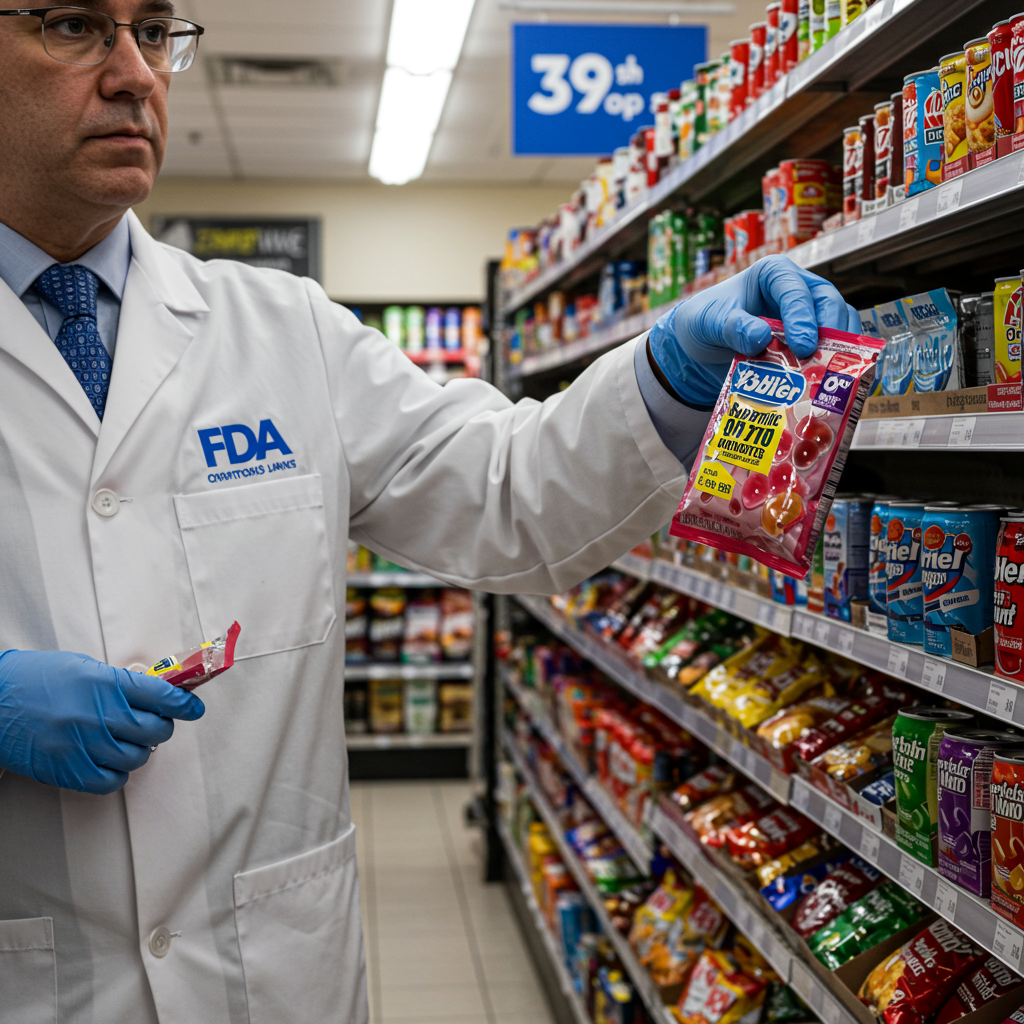A major shift is underway in the landscape of unregulated supplements: the Food and Drug Administration (FDA) is taking decisive action to restrict a potent synthetic opioid, 7-hydroxymitragynine (7-OH). Commonly found in readily available products like gummies and drinks sold in convenience stores, this substance has ignited significant alarm among health officials. While natural kratom leaf has its own complex history, the FDA emphasizes a crucial distinction, highlighting 7-OH as a serious public health risk separate from the traditional botanical.
This move underscores growing concerns about the accessibility of highly concentrated, synthetic substances that mimic controlled drugs. The agency’s recommendation to classify 7-OH as a Schedule I controlled substance – a tier reserved for drugs like heroin and LSD with no recognized medical value and high abuse potential – signals an urgent response to a rapidly evolving public health challenge.
Understanding 7-OH: A Potent New Concern
7-hydroxymitragynine, or 7-OH, is a substance synthesized from a compound naturally present in the kratom leaf (Mitragyna speciosa). While traditional kratom, derived from trees native to Southeast Asia, contains only trace amounts of 7-OH (typically less than 0.05%), commercially available 7-OH products feature highly concentrated, semisynthetic extracts. Dr. Christopher McCurdy, a professor of medical chemistry at the University of Florida College of Pharmacy, starkly describes this as “essentially putting legal morphine at the gas station.”
External research highlights the dramatic difference in potency. While mitragynine, kratom’s predominant alkaloid, offers mild stimulant and mood-boosting effects at low doses, concentrated 7-OH preparations are a different story. Experts reveal 7-OH is 30-40 times more potent at opioid receptors, leading to rapid-onset analgesia, euphoria, and dangerous respiratory depression, alongside classic opioid-type withdrawal. Some independent lab tests have even found “kratom extract” pills exceeding 40% 7-OH purity, far beyond what the American Kratom Association deems acceptable for “true kratom.” This extreme concentration raises serious questions about its abuse potential and safety.
Why the FDA Is Acting Now
The FDA’s proactive stance on 7-OH stems from mounting evidence of its significant health risks. Commissioner Marty Makary articulated the agency’s view, stating that the public health risk posed by 7-OH products is “night and day” compared to natural kratom. The agency’s report detailed concerns including severe sedation, nausea, breathing problems, and a high risk of addiction. This urgency comes amidst the nation’s ongoing drug crisis, fueled by illicit fentanyl and other synthetic compounds.
The FDA’s current recommendation to the Drug Enforcement Administration (DEA) for Schedule I classification reflects their assessment of 7-OH’s profound danger. This classification suggests no medical benefit and a high potential for abuse, a category that famously still includes marijuana at the federal level, despite recent efforts to reclassify it. DEA Deputy Assistant Administrator Thomas Prevoznik has indicated the agency will review the 7-OH recommendation “expeditiously.” This action also follows the FDA sending warning letters to several companies, accusing them of illegally marketing 7-OH as dietary supplements or unapproved drugs for pain or anxiety relief, often in forms appealing to young people, like gummies and candies.
Kratom’s Shifting Landscape and Public Debate
The scrutiny on 7-OH adds another complex layer to the ongoing story of kratom in the United States. For years, kratom has grown in popularity, with users often seeking alternatives for chronic pain management or relief from opioid withdrawal symptoms. Estimates suggest between 2 million and 16 million Americans use kratom, with retail sales reaching approximately $2.2 billion in 2024. Smoke shops, gas stations, convenience stores, and online retailers widely sell various kratom products, and a devoted user base champions its perceived health benefits.
However, the scientific community and regulatory bodies express considerable caution. While kratom’s compounds can induce euphoria similar to opioids at higher doses, experts note it’s generally less potent than many legal painkillers. One of kratom’s natural compounds is metabolized into 7-OH, which produces an opioid-like effect in the brain. The critical distinction lies between the trace amounts in natural leaf and the potent, concentrated synthetic forms.
Industry Divide and Regulatory Challenges
The kratom industry itself is divided on 7-OH products. The American Kratom Association (AKA), a prominent trade group, views companies selling “enhanced” 7-OH products as “bad actors.” AKA spokesman Mac Haddow stated, “We do not believe these products should be available over the counter,” arguing they distort public understanding of kratom and fuel critics who seek to ban all plant products. They advocate for regulation to ensure product safety and quality.
Conversely, the Holistic Alternative Recovery Trust (HART), another trade association, defends 7-OH products, calling the criticism an “intra-industry turf war.” HART’s national policy director, Jeff Smith, asserts that consumers find such 7-OH products “more effective and safer,” though he supports measures like warning labels, age restrictions, and third-party lab testing. However, Smith criticized the FDA’s proposals, questioning the scientific basis for alleged dangers and predicting a ban could push users toward more dangerous substances.
Risks, Lawsuits, and the Call for Regulation
The debate over 7-OH and kratom’s safety is not just theoretical. There have been wrongful-death lawsuits against retailers. An $11 million wrongful death lawsuit was awarded to the family of Krystal Talavera, a Florida mother who died after consuming kratom, with the coroner citing “acute mitragynine intoxication.” Her lawyer argued the product was irresponsibly marketed without adequate warnings. While kratom-associated deaths are relatively rare compared to the number of users, and often involve other illicit drugs, the potential for harm, especially with highly potent synthetic derivatives, is clear.
The FDA has consistently warned against kratom’s use due to risks including liver toxicity, seizures, and substance use disorder (SUD). Dr. Petros Levounis expresses alarm over the misconception that kratom is a safe treatment for opioid use disorder withdrawal, emphasizing that evidence for this is limited and that kratom itself can lead to addiction and withdrawal symptoms. Clinicians are urged to routinely ask patients about kratom use, particularly specific brand names, as users often perceive it as a harmless supplement. The primary reason many individuals use kratom clinically appears to be self-medication for kratom withdrawal, perpetuating a cycle of dependence.
Federally, kratom and 7-OH are not controlled substances, despite kratom remaining on the DEA’s “Drugs of Concern” list. Regulation is a patchwork at the state level: some states ban it, others have specific restrictions, and many lack statewide regulations. This “grey area” allows wide availability but raises concerns about product contamination and unregulated dosages. Many experts and even some industry groups argue that a complete ban might be counterproductive, potentially pushing users to more dangerous, illicit substances. Instead, they propose comprehensive regulation, including standardized manufacturing, labeling, and potency limits, to ensure consumer safety and product quality.
Frequently Asked Questions
What are the primary health risks associated with 7-OH, and how does it differ from natural kratom?
7-hydroxymitragynine (7-OH) is a synthetic substance derived from kratom, but it is vastly more potent than the trace amounts found naturally in kratom leaves. The FDA warns of significant risks including severe sedation, nausea, breathing problems, and a high potential for addiction, similar to traditional opioids. Experts state 7-OH is 30-40 times stronger at opioid receptors than kratom’s main compound. Natural kratom, conversely, offers milder stimulant and pain-relieving effects, with experts like Dr. Christopher McCurdy drawing a stark distinction between the two due to 7-OH’s highly concentrated, engineered nature.
Why is the FDA recommending 7-OH be classified as a Schedule I substance, and what does this mean?
The FDA is recommending that 7-OH be classified as a Schedule I controlled substance because it has determined there is no accepted medical use for the substance, and it has a high potential for abuse and addiction. This classification, currently shared by drugs like heroin and LSD at the federal level, would mean that manufacturing, distributing, or possessing 7-OH without authorization would be illegal. This move reflects the agency’s urgent concern over 7-OH’s potency and the public health risks it poses, especially given its widespread availability in unregulated products.
What is the current legal status of kratom, and how might the proposed 7-OH restriction affect the broader kratom market?
Currently, kratom is not a federally controlled substance in the U.S., though it remains on the DEA’s “Drugs of Concern” list. Its legal status varies by state; some states have banned it outright, while others have specific regulations or none at all, creating a patchwork of laws. The proposed restriction of 7-OH aims to isolate a particularly potent and dangerous synthetic derivative from the natural kratom plant. While the FDA asserts it is not seeking to restrict natural kratom products, a Schedule I classification for 7-OH could intensify the broader debate around kratom regulation and potentially lead to stricter controls or further legislative actions at both federal and state levels.
The Future of Kratom and Synthetic Derivatives
The FDA’s decisive move to restrict 7-OH highlights the ongoing struggle to regulate a rapidly expanding market of botanical and synthetic compounds. As the nation continues to grapple with the opioid crisis, the emergence of substances like 7-OH, easily manufactured and widely available, presents a unique challenge for public health officials. This situation underscores the critical need for continued research into the pharmacology, long-term effects, and potential therapeutic uses of both natural kratom and its derivatives.
Ultimately, public awareness and education are paramount. Consumers must understand the significant differences between natural botanicals and highly concentrated, synthetically enhanced products. As regulatory bodies like the DEA review the FDA’s recommendation, the outcome will undoubtedly shape the future accessibility and legal landscape of these controversial substances, impacting millions of users and the broader public health.
Word Count Check: 1085 words



